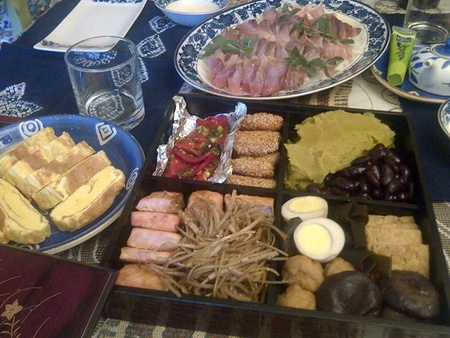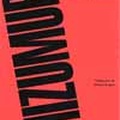I remember when I was a kid I preferred milanesas (breaded meat cutlets) with mashed potatoes to the Japanese meals that my mother prepared everyday—along with omisoshiru that my father consumed religiously and that we kids rejected. Perhaps because we were sick and tired of consuming it, or it may have been our way of protesting. It was my parents who raised me not to leave anything on the plate and to be thankful for our food.
At that time, eating Japanese food was confined to only Japanese families. It was unthinkable that a meat-loving Argentine would eat raw fish!
My mother cooked fish all different ways; she also made katsudon, oyakodonburi, and there always was some tsukemono and, when we had visitors, the dishes were a little bit more sophisticated: chirashi zushi, sashimi, sukiyaki, etc. When we returned from school and had lunch, there was always chahan—sauteed rice—with vegetables and chunks of meat mixed with the leftovers from the night before. To eat chahan every single day was tiresome, and we rejoiced with my sister everytime milanesa, baked meat, or some kind of steak was served to us.
Years ago—and even today in Buenos Aires—there were dozens of Japanese restaurants that ranged from the most traditional style of preparing Japanese food to restaurants that any Japanese would reject as so-called authentic food. The word sushi has become so westernized that any Argentine can order it in a sophisticated restaurant or buy it in the supermarket. And in these last few years, coming from the likes of Niseis and Sanseis, new restaurants have opened that, besides nigiri and maki, also offer other culinary specialities such as yakitori, udon, and ramen. Today, Nikkei youth enjoy Japanese food.
During family reunions of years past, it was common that there were some makizushi, chirashizushi, onitsuke, osekihan, karinto, and kanten prepared, and every Japanese woman in the Japanese Association had her own specialty. My mother, if I remember correctly—and depending on the time—when she learned a new recipe, she would keep making it until she got it right. We got tired of eating it every single day. She also did a good job making amanatto, karinto, kanten, etc.
But, today, at family reunions or when getting together with friends where the Issei are a minority, dinner companions enjoy eating Japanese dishes. The majority like to eat Japanese food! Of course, those who learn how to cook Japanese-style meals earn applause from friends and family. Every Nikkei family prepares food in their own way, according to a particular family palate and the particular tastes of the mother and grandmother. Every region of Japan—in fact, every prefecture, every town—has its own way of flavoring food and cooking. It makes sense that the same thing would happen here with Japanese families.
The person writing this essay has recently become an adult, and has accepted the tastes and flavors of her parents’ homeland. She learned to eat fish, to consume mishoshiru, and—more recently—to eat natto. She discovered Okinawa’s cuisine, which differs from her mother’s style of cooking from the Honshu region in eastern Japan, but which also has a touch of central Japanese culinary traditions in it. She understood that for her parents it was a way to remember the past and maintain ties to their native land.
I recall that we always had Japanese guests come to our house: my bachelor uncle or a Japanese man married to an Argentine woman, etc., all who enjoyed my mother’s cooking. My mother arrived in Argentina at the age of twenty and married my father. According to my mother, she learned it all from Garin no obasan (my aunt from Garín). My dear great-aunt, whom we called “baian” because I was unable to pronounce the word obaachan. She was always cooking for a lot of people. Several young people from Japan worked in her house as they transitioned into their new life in Argentina. My father was one of those young people. Garin no obasan, therefore, became his adopted mother in Argentina. She taught my mother how to make maki sushi, inari sushi, onitsuke, karinto, kanten, yokan, and, of course, milanesa and other Argentine dishes.
I recall that at the end of each year, in Baian’s Garín house, mochitsuki was prepared, which is to say, they prepared the mochi in the traditional way. The men were in charge of using a wooden stick known as mochigome, which was placed in a wooden bowl called usu. Afterwards, the women would soak such things in water to ensure that the mochigome would not stick. They repeated the action until the dough was ready to be eaten. Thus, we began the new year in this manner, eating oshiruko and ozoni. How I enjoyed seeing the mochitsuki! Over time, however, technology provided new ways to make the mochi. In the beginning my mother would complain because it didn’t have the consistency of traditional mochi, but it certainly reduced the amount of work that was required. I also lament this kind of technology because it has taken away our ability to enjoy what was truly an incredible experience.
Baian inspired her granddaughters to start a new candy business. They learned from their mother who learned from their mother who had learned it from Baian. They are the third generation in our family. They make wonderful sushi, udon, and are disposed to use any recipe. I am sure that they are the ones who are going to pass on to their own kids the rich traditions that Baian started for her family and friends.
Without wanting to, however, Baian left an important legacy, and every Baian in Argentina passed on the Nikkei cooking traditions that were found in their respective families.
In honor of them: Itadakimasu!
© 2012 Mónica Kogiso







